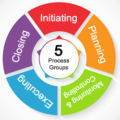
The Project Management Institute’s (PMI) definition of a project is considered by many to be the official definition:
- A temporary endeavor undertaken to create a unique product, service, or result.
Two words within that definition are the key to understanding what a project is and isn’t:
- Temporary: A project has a distinct beginning and end. The muddier these boundaries are, the more potential for conflict there is among its stakeholders. Also, there are two factors that come into play in virtually every project: Time (deadlines) and money (budgets). Because of their fixed beginning and end, these two variables are by definition fixed as well.
- Unique: Theoretically, no two projects are the same. In the extreme case you might have a project that produces 100 widgets for someone and another that produces 100 widgets for that same customer. But these are separate projects because they have separate schedules. You cannot call it 100 projects because those are identical. That would be an operations (ongoing) activity.
The Project Manager
The project manager is:
- The person assigned by the performing organization to lead the team that is responsible for achieving the project objectives.
They are responsible for the success or failure of the project. They are separate from a functional manager who is in charge of a work unit, or an operations manager who is in charge of an ongoing “program.” Although the project manager may report to either of these types of managers, their responsibility ends at the boundaries of the project.
The project manager normally reports to a person called a project sponsor. This person is not responsible for the day to day activities of the project, but is often tasked with some of the responsibility for the project’s success or failure. They are often responsible for the project’s funding, as well as approving project changes such as to the deadlines or budgets. They are often the person that accepts the project’s deliverables.
Project Management
The management of a project is defined by PMI as follows:
- The application of knowledge, skills, tools, and techniques to project activities to meet project requirements.
Project management includes the application of many skills, which include:
- Dividing the project into tasks
- Creating schedules (deadlines)
- Estimating budgets
- Determining project scope
- Communicating with stakeholders
- Acquiring the project team
- Developing and mentoring the project team
- Ensuring the availability of resources
- Ensuring high quality deliverables
- Monitoring and controlling change
Project changes are generally where the project manager earns their money. Most projects experience pressure to go over budget, miss deadlines, or experience scope creep. The ability to implement project controls to keep the project on cost and/or schedule is foundational to project management.
Project Management Plan
According to the Project Management Body of Knowledge (PMBOK), the project manager develops a project management plan, including the budget and schedule, and the project sponsor approves it. Any changes during the project are then re-approved by the project sponsor and recorded in a change log.
The project management plan contains anything of interest to the stakeholders regarding the management of the project, but includes:
- Scope statement
- Deliverables
- Success factors
- Schedule
- Budget
- Quality standards
- Project team needs – positions, job descriptions, etc.
- Stakeholder list
- Procurement plan
- Risk analysis
Project Life Cycle
The following is the project life cycle according to the PMBOK.
- Project Initiation. The tasks involved with the creation of the project, initial funding, and authorization of the project manager.
- Project Planning. The creation and approval of the project management plan.
- Project Execution. The production of the deliverables.
- Monitoring & Controlling. Ensuring the project stays within the boundaries of the project management plan.
- Project Closing. Releasing project resources.
They are in chronological order except for #3 (Execution) and #4 (Monitoring & Controlling) which are in parallel. However, the sequence can restart throughout the life cycle of the project as well, for example when a major project phase is complete the project could revert back to the planning stage.
Project Management Documents
To effectively manage a project professionally, the project manager creates documents which assist in planning, executing and tracking the project. The following list can be sufficient for small projects:
| Phase | Document |
|---|---|
| Initiating |
|
| Planning |
|
| Execution |
|
| Controlling |
|
| Closing |
|
These documents are described as follows:
- Project Charter
This document serves to authorize the project and assign the project manager. It is “above” the project and provides overall guidance to the project for things like why the project was created, what the major deliverables are, and what business need it is solving. It is primarily the responsibility of the project sponsor. - Project Management Plan
This document informs all stakeholders how the project will be managed. It is the project manager’s guide to the project and contains the master schedule, budget, and any other item of concern for the project. - Project Status Reports
During the project’s execution phase, regular status reports are produced by the project manager or their designate. These status reports contain earned value analysis to report the project’s schedule and budget progress, the project manager’s commentary on progress, and so forth. - Stakeholder Communication
During the project’s execution phase the stakeholder’s must be communicated with as necessary to ensure a satisfactory project outcome. Ideally, the project management plan should contain a list of stakeholders together with their regular communication requirements (approval of deliverables, newsletters, investor circulars, etc.) but whenever a stakeholder requires communication with the project team a record of the conversation should be generated. - Change Logs
When changes are inevitably required the project manager must enter the changes into the project’s Change Log. This allows tracking to ensure those mistakes, if they are indeed mistakes, to be avoided and lessons learned applied to future projects. - Variance Reports
Although earned value metrics are an integral part of the project status reports, above, the production of those metrics can and should happen at any time. The more, the better. The project manager needs to be aware of the project’s schedule and budget status at any time, so that early action can be taken when the project starts trending out of its schedule and/or budget baseline. - Project Closure Report
This report should not be overlooked. It is important to document how the performed relative to its original project management plan. The estimating of future projects also requires a good, easily accessible record of actual timelines and costs (i.e. analogous estimating).











Leave a Reply